Woburn Sands and Aspley Heath War Casualties
Between the Wars
The clock of the village Memorial was already causing concern by 1920, as it could not be kept running on time. Mr William Janes, the local watch maker, was put in charge of it. In 1922, repairs were carried out by the manufacturers, costing £7.10s, which were attributed to the mechanism being damaged by brick dust from the local yards. In 1926, it was decided to replace the weight driven clock with an electric one, controlled by a master clock to be housed in ‘The Swan’. Tenders were invited for the work, and the local watch and clock makers, Thomas Emms and his step-brother Erasmus George Dovey, undercut the original clock suppliers. The new clock cost £46.16s.7d to buy and install, and the cost was met by subscriptions from the villagers.
The Second World War
When Britain was plunged into the Second World War, warning lamps were placed around the base of the Memorial due to the blackout regulations, and kept in order by Leslie Leigh-Lancaster, who had his shop close by. The parish names cut into the inscription were also filled in, by Mills and Son of Woburn, under the Defence Regulations, so that should invasion occur, the enemy would not know where they were!
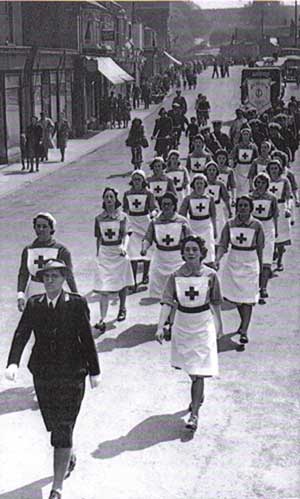
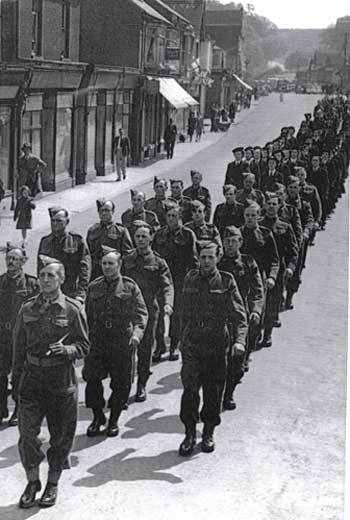
The end of the War was marked in style in Woburn Sands:
“The news of the surrender of Germany was the signal for flags, streamers and bunting to appear in all the streets and on all buildings. Thanksgiving was, however, uppermost in the minds of most people, and services were held at St. Michaels Church, conducted by the Rev. F. Y. Orlebar, and the High Street Methodist Church, conducted by the Rev. Josiah Martin, on Tuesday afternoon.
In the evening bonfires were lighted in several parts of the village, and impromtu dancing took place in the Square until a late hour.
On Wednesday the mothers and friends of children in Wood Street gave a tea in the street, where two long tables gaily decorated, were piled high with good things to eat, contributed solely by Wood Street residents.
A similar tea was organised by the residents of Russell Street. Later, a parade in fancy dress toured the vilage to the accompaniment of barrel organ music, and the celebration culmenated with a huge bonfire in Pratts Field, where an effigy of Hitler wa swallowed in the flames.
On Saturday the children were given a tea in the Aspley Hill Methodist Church schoolroom, and in a fancy dress parade which followed, prizes were won by Brian and Irene Ansell, Mary Wilmot, Nina Wright and Bernard Capp.” From the North Bucks Times, 15th May 1945.
Many local soldiers returned with stories of their adventures, like Corp Derek Hawley, formerly a provisions shop assistant:
HE WAS CAUGHT IN ENEMY TRAP – MEDITIRRANEAN ORDEAL OF WOBURN SANDS CORPORAL – By a Military Observer.
“Three privates and I were the only ones out of our party that got away,” said Cpl. Derek M. Hawley, of “Daytone” 8, Station Road, Woburn Sands, at present stationed in Greece with a battalion of the Leicester Regiment, describing an action he went through in Italy.
“We crossed a river – more like a canal, it was, a narrow affair you could almost have jumped across. Jerry had left a ladder over it; we were going forward to see what was there; I think he’d left tho whole set-up as an ambush, myself.
“Anyhow, we crossed and went about 500 or 600 yards, and then they just opened up on us from all sides. The river was mined, we didn’t realise that till afterwards; there were stakes, with mines tied-to them, in the river bed. We discovered them on our way back.
“I was with one section and was lucky enough to be able to get into a ditch. I opened up on a sniper who had got four chaps beside me; I got the chap with a Piat to let him have something on account and after a couple of Piat shells, there was no more firing from him. But I think they were too busy tackling the rest of them to pay much heed to us, and that’s how we survived.
“There was no chance of getting forward, and after about three hours we decided to go back. We made a dash for it; three got away then, and two joined us later.” From The North Bucks Times, 8th May 1945.
But some did not return. By the end of the war, there were more local men who had lost their lives in the service of their country, and their names had to be added to the Memorial. Mrs Hunt, of the Welcome Home Committee suggested adding the names in April 1946, and there was no objection from the council. The inscribed panel was fixed to the Memorial in October 1947, and officially unveiled the next month by Mr C. Hart, an ex-POW of the Far East, in the presence of the Rev. Frederick Bowler of St. Michaels, and the Rev. Arthur Manley of the Methodist chapel. The seven names added were:
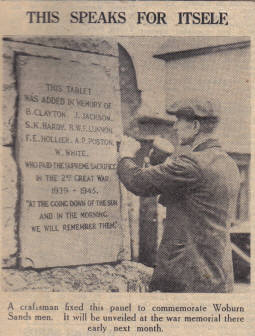
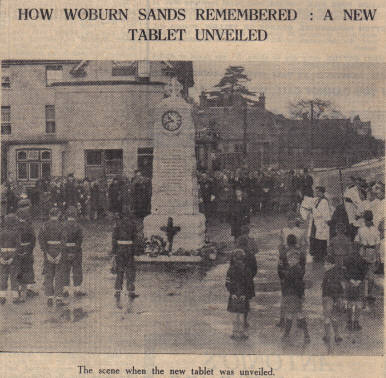
Mr Emms retired from looking after the clock in 1947, so Mr Janes stepped forward again, until someone else could be found. In November 1952, an enquiry was sent to the Parish Council as to why the name of John Shelton had been omitted from the Second World War names on the Memorial. The Welcome Home Committee were asked to explain, and said that the name had been put forward at the time, but after investigation they had decided he was not eligible, as there was doubt that he was actually serving at the time of his death. The council decided to stand by this decision. However, in January 1954, Mrs F. Marchant raised the subject again, and provided a letter from Major General Bailey, of the War Office, which confirmed John’s military service. With this evidence, and acknowledging the fact that John was not listed on any other Memorial in England, the Council decided to act, and in March they instructed Mills and Son of Woburn to add the name, and so an eighth name was added to the Second World War names. This had definitely been done by August that year.
| Added by August 1954: |
|---|
There were also two names recorded on a plaque in the NatWest Bank on the High Street, until it closed in 2017. The plaque was renovated and moved to the Central Milton Keynes branch of the bank:
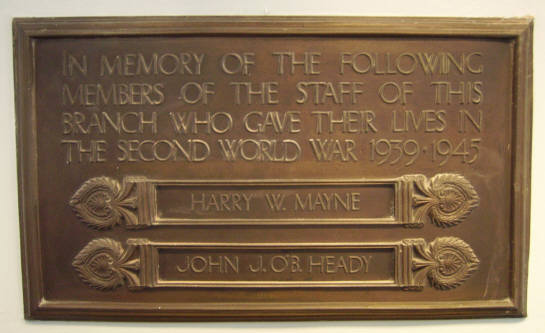
SERGEANT HARRY WILLIAM MAYNE
No. 1176480, RAF Volunteer Reserve. Died 19th August 1942, aged 30, and buried at Eyeworth Churchyard, Bedfordshire. Son of Robert and Lilian May Mayne of Eyeworth. No further details currently known.
FLIGHT SERGEANT JOHN JOSEPH O’BRIEN HEADY
No. 1615776, RAF Volunteer Reserve, 153 Sqn. Killed 14th February 1945. The 153 Sqn. were flying Avro Lancasters, and according to their history: “14th February, the city of Chemnitz received its first major Bomber Command attack, but due to extensive cloud cover, allowing the use of sky-marking techniques only, bombing proved mainly scattered and ineffective. The Squadron suffered another loss when NN 803 (P4-2ndO) crashed over East Germany, whilst on its first operation – in fact, it had recorded only 64 hours of total flight time prior to take-off. The crew, on only their third operation, comprising F/Lt Clem Mills with 4 fellow Canadian and 2 RAFVR members (of whom the F/Engineer, F/Sgt J J Heady, was a remustered pilot) were all killed.” The RAF index records that his plane, NN 803, took off from Scampton at 8.05pm and continued “…as part of the second wave. Crashed, burning fiercely, at 0044 between the villages of Arnsfeld and Grumbach, having being targeted by Ofw Ludwig Schmidt piloting a Ju88G-6 from 2./NJG6.’ Remainder of summary as reported. Apparently, a man from the nearby village of Mildenau recalls that a friend of his, at the time aged 14, was drawn to the crash site as he had heard that RAF airmen were issued with chocolate. The lure of this induced him to search the badly burnt wreckage which was lying in woodland. However, on seeing two of the crew still strapped in their seats he quickly left the scene and never returned. He said, however, that he saw unexploded bombs.” [Jörg Helbig and Rene Siegert]
Heady appears on the Leighton Buzzard Cedars School Roll of Honour, and also on Linslade Memorials.
Other Second World War casualties connected with Woburn Sands
As with the First World War, there are other casualties connected with Woburn Sands. These are their details:
ALBERT EDWARD NOEL CHAMPKIN, National Fire Service. Died 1st May 1943.
Son of the late William and Sarah Champkin, of Woburn, Bletchley; husband of Eva Maria Champkin, of 25 Downham Road, Woburn Sands, Bletchley. Died at junction of Russell Street and High Street, Woburn Sands. Aged 40. Classed as a Death in Service.
PRIVATE WILLIAM JACK HOOPER, No. 119593, Royal Electrical and Mechanical Engineers. Died 23rd March 1947.
Son of Herbert and Lilian Beatrice Hooper; husband of Rose Elizabeth Hooper, of Woburn Sands, Buckinghamshire. Aged 31. Memorial at Golders Green Crematorium.
According to the Corps Archivist at the REME Museumof Technology, the records show that William was “Y Listed” on 18th September 1942 whilst serving at Oxshott. The “Y List” is a list of soldiers who do not belong to a specific unit, due to a long stay in hospital; in military prison; or on a long course. William was subsequently discharged from the Army on 4th May 1943 under King’s Regulations Paragraph 390 (XVI) – i.e. for ceasing to fulfil Army medical requirements.
In the Archivists view, he was probably either wounded or had a critical illness in September 1942 and, as a result, spent 9 months in hospital. After 9 months he was medically discharged from the Army, and if he died as a result of the wounds or illness he sustained whilst serving, it would be normal practice for this to be considered as a War Grave entry.
LANCE CORPORAL CHARLES WALTER JESKINS, No.1549513, Pioneer Corp., Died 22nd May, 1945. Whilst stationed at Whaddon, Charles fell from the back of an army lorry in Aspley Heath. The lorry was hauling a trailer full of 5 tons of timber. He was taken to Luton and Dunstable Hospital, but died soon after arrival. He was buried at his family home of Marlow. Aged 30.
LANCE CORPORAL JOHN EDWARD KNOPP, No. 5830418, Cambridgeshire Regiment, 2nd Battalion. Died 21st September 1944.
Son of George G. and Lilian B. Knopp, of Woburn Sands, Buckinghamshire. Aged 25. Born and resided in Essex. Appears on the Singapore Memorial. He was a Japanese prisoner of war, being transported to Japan from Manila, on the ship Hofuku Maru. It was sunk by planes from an American aircraft carrier, who were unaware what the ship was carrying, as the Japanese refused to mark their ships. A total of 1047 prisoners died on this ship.
LANCE CORPORAL ALEC (ARTHUR) PEACOCK, No. 855064, is buried in St. Michaels churchyard, Woburn Sands. He was a Military Policeman who died 30th March, 1941, aged 22. He is remembered on the Bletchley War Memorial
FLIGHT LIEUTENANT FRANCIS EVELYN GEORGE RASHLEIGH, D.F.C., No. 41064, Royal Air Force. Died 30th September 1943.
Son of the Revd. William Rashleigh, M.A., and of Katherine M. T. Rashleigh, of Woburn Sands; husband of Ann Rashleigh. Francis was in an Anti-Aircraft Co-operation Unit, in 202 Squadron, and obtained his Distinguished Flying Cross in August 1941, whilst stationed in Gibraltar. He rescued the crew of an aircraft which had come down on the French Moroccan coast and been surrounded by 200 hostile Arabs. He managed to land out of sight of most of the Arabs, but near enough for the crew to dash to safety. They scrambled aboard under fire and the pilot immediately turned the tail of his plane towards the enemy, opening his throttle and hiding their aircraft’s take-off behind a cloud of dust.
He had lived in Balcombe in Sussex, and the processional cross used in the village church has his name on it. He appears on the Alamein Memorial and on the War Memorial plaque in Balcombe Church. Aged 23.
Today, the RAF’s E flight, 202 Squadron, are based at RAF Leconfield, and perform rescue work from a purpose-built hangar and operations centre named after Frances Rashleigh, who’s Distinguished Flying Cross was the Squadron’s first recorded gallantry award for a rescue mission.
LIEUTENANT JOHN HENRY LLOYD SULMAN, M.B.E., D.S.C. Royal Naval Volunteer Reserve, H.M. Trawler Colsay. Died 2nd November 1944.
Son of James Hugh and Lilian Elsie Sulman, and husband of Zillah Sulman, of The Nook, Woburn Sands, Buckinghamshire. Aged 35.
He received his Distinguished Service Cross in October 1943 for work on minesweeping; awarded for courage and skill in many successful minesweeping operations in Mediterranean waters while serving in HM Ships Negro, Elbury, Achroite and Triton and HM Motor Minesweepers 47, 68, 80 and 171. After D-Day, in August 1944, a communications error led to several Royal Navy minesweepers being attacked by Allied planes off the coast of France. Several ships were sunk, and the rescue of men in the water made difficult by shelling from the German shore batteries. Lieutenant Sulman of HMS Colsay was injured in the back during the incident, along with four other ship commanders, for their handling of the incident.
H.M. Trawler Colsay was a Danlayer. A dan is a marker buoy which consists of a long pole moored to the seabed and fitted to float vertically, usually with a coded flag at the top. Dan laying was an important part of minesweeping, and boats were fitted specifically for this purpose. The task of a danlayer was to follow the minesweepers as they worked an area, and lay the dans which defined the area swept and made it obvious where the clear channels were. It was sunk by a Neger (a German torpedo-carrying miniature submarine) off Ostend. He was awarded the MBE after his death, for his conduct in the friendly-fire incident, and appears on the Royal Naval Patrol Service Memorial at Lowestoft, and on the Wavendon Memorial.
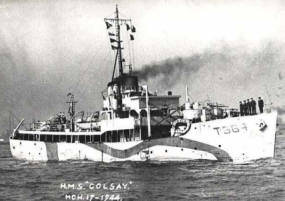
ABLE SEAMAN ANTHONY JOHN WADE, No. C/JX 336396, Royal Navy, H.M.S. President III. Died 7th December 1942.
Son of Thomas and Nellie Wade, of Woburn Sands. He worked at Eastmans Butchers. H.M.S. President III is not a ship, but a land-based training establishment, where Royal Navy Gunners were trained. He was onboard the ship M.V. Peter Maersk, bound from Liverpool to Aden and Alexandra via Saldanha Bay and Capetown with a cargo of 5244 tons of government stores and general cargo. At 03.40am, whilst sailing independently, it was torpedoed by U-185, west of the Azores, and sank after two coups de grace hits at 04.52am and 05.31am. The master, 56 crew members, eight gunners and two passengers were lost. There were no survivors. Appears on Chatham Naval Memorial and Aspley Guise Memorial, inside St Botolph’s Parish Church. Aged 19.
After the Second World War
In 1959, the Billiards Room at ‘The Swan’, where the clock controls were housed, was demolished. The licensee, as well as the brewery owners, had to be persuaded to rehouse it in another part of the outbuildings. The council decided to alter the clock to mains power, however, after receiving the quote of £110 for conversion, and about £4 a year for electricity, they decided the old mechanism was good for another 5 years.
The Memorial stood approximately where the mini-roundabout is, outside ‘The Swan’. The traffic flow through the centre of the village had increased greatly since 1919, and in 1961 came the first thoughts of re-aligning The Square, and having proper signs to direct traffic around it. The Memorial was blamed for causing traffic accidents, as it had been hit many times by cars and lorries, but the plans all came to nothing.
In 1962, the clock was again giving trouble, and now the garages housing the master clock at ‘The Swan’ were earmarked for demolition to widen Hardwick Road. The County Council were asked for somewhere to accommodate it, and pay for its removal. The County Surveyor made the first official suggestion of moving the Memorial at a meeting in June 1962. The British Legion was asked their opinion, and they replied that it was alright by them if it was a benefit to the public and met with approval from their own members and the parishioners. Aspley Heath Parish Council objected, saying that it was useful as a pedestrian refuge in the middle of the junction. After a lot of debate, it was decide to leave the Memorial where it was.
It was finally decided to connect the clock to mains power in April 1963, and the work was done by English Clock Systems at a cost of £54.12s.6d, with volunteer help from Councillor Fred Watkiss, who worked in maintenance at Cranfield College of Aeronautics, and Mr Hilton. Moving the Memorial was again suggested in March 1964, when Bedfordshire and Buckinghamshire Council representatives met and looked at the problem. A parish meeting was held, but only about 35 people turned up. The general feeling was for the Memorial to stay in The Square, even if it was slightly repositioned, and so the County Councils were informed that it would not be being moved.
It was six years before the subject was brought up again, following another spate of traffic accidents. Although the decision was taken in 1970, it took a further 18 months for the plans to be finalised. The Memorial was to be moved to a site outside the entrance to Shelton Court, about 100 yards from where it had stood for 53 years. On 21st February 1972, the three and a half ton Memorial was packed in a protective wooden case and transported by a fork lift truck from Lancer Boss of Leighton Buzzard, driven by Mr James West. The operation was overseen by Mr John Mitchell of MAC Ltd., a civil engineering firm from Bletchley.
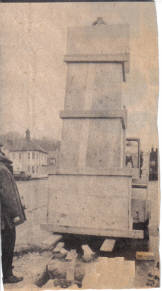
The idea of moving it with a fork lift is credited to his 14 year old daughter. The new position was central in the High Street and would be surrounded by a Garden of Remembrance. Shelton Court had been named after the vicar who officiated at the unveiling in 1919. The Memorial being moved in 1972.
In 2000, the Town Council had the Memorial professionally cleaned, and the lettering was re-carved and picked out in black to be more distinctive, as most of it had worn away in the passage of the years.
There were many others with connections to Woburn Sands and Aspley Heath. Some were born here, but moved away before the war, or were well known in the area because they worked here. Some had family connections in the district, or perhaps their families moved during the war, so their names are recorded on other local memorials elsewhere. It is not possible to list them all.
Our War Memorial continues to be the centre of the local Remembrance Day proceedings, and is a focal point for recognising the sacrifices made by others, so that we are able to enjoy our freedom today.
Page last updated Jan. 2018.
